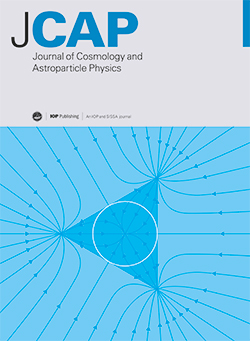Equatorial periodic orbits and gravitational waveforms in a black hole free of Cauchy horizon
IF 5.9
2区 物理与天体物理
Q1 ASTRONOMY & ASTROPHYSICS
Journal of Cosmology and Astroparticle Physics
Pub Date : 2025-07-08
DOI:10.1088/1475-7516/2025/07/021
引用次数: 0
Abstract
In this paper, we study the periodic orbits and gravitational wave radiation in an extreme mass ratio inspiral system, where a stellar-mass object orbits a supermassive black hole without Cauchy horizons. Firstly, by using the effective potential, the marginally bound orbits and the innermost stable circular orbits are investigated. It is found that the radius, orbital angular momentum, and energy increase with the hair parameter for both orbits. Based on these results, we examine one special type of orbit, the periodic orbit, around the black hole without the Cauchy horizon. The results show that, for a fixed rational number, the energy and angular momentum of the periodic orbit increase with the hair parameter. In particular, we observe a significant deviation from the Schwarzschild case for small hair parameter with a large amount of external mass outside the black hole horizon. Moreover, we examine the waveforms in the extreme mass ratio inspiral system to explore the orbital information of the periodic orbits and the constraints on the parameters of the black holes. The results reveal that the gravitational waveforms can fully capture the zoom-whirl behavior of periodic orbits. Moreover, the phase of the gravitational waves imposes constraints on the parameters of the black hole solutions. As the system evolves, the phase shift of the waveforms becomes increasingly significant, with cumulative deviations becoming more pronounced over time. Compared to the Schwarzschild black hole background, the waveform phase will advance for the central supermassive black hole without a Cauchy horizon.无柯西视界黑洞的赤道周期轨道和引力波形
本文研究了在一个极端质量比吸气系统中,一个恒星质量物体围绕一个没有柯西视界的超大质量黑洞运行的周期轨道和引力波辐射。首先,利用有效势,研究了边缘束缚轨道和最内层稳定圆轨道。结果表明,两种轨道的半径、轨道角动量和能量均随毛参数的增大而增大。基于这些结果,我们研究了一种特殊类型的轨道,即没有柯西视界的黑洞周围的周期轨道。结果表明,在有理数固定的情况下,周期轨道的能量和角动量随毛参数的增大而增大。特别是,我们观察到在黑洞视界外有大量外部质量的情况下,小毛参数与史瓦西情况有明显的偏差。此外,我们还研究了极端质量比吸气系统的波形,以探索周期轨道的轨道信息和对黑洞参数的约束。结果表明,引力波可以完全捕捉到周期轨道的变焦-旋转行为。此外,引力波的相位对黑洞解的参数施加了约束。随着系统的发展,波形的相移变得越来越明显,随着时间的推移,累积偏差变得越来越明显。与史瓦西黑洞背景相比,没有柯西视界的中央超大质量黑洞的波形相位将提前。
本文章由计算机程序翻译,如有差异,请以英文原文为准。
求助全文
约1分钟内获得全文
求助全文
来源期刊

Journal of Cosmology and Astroparticle Physics
地学天文-天文与天体物理
CiteScore
10.20
自引率
23.40%
发文量
632
审稿时长
1 months
期刊介绍:
Journal of Cosmology and Astroparticle Physics (JCAP) encompasses theoretical, observational and experimental areas as well as computation and simulation. The journal covers the latest developments in the theory of all fundamental interactions and their cosmological implications (e.g. M-theory and cosmology, brane cosmology). JCAP''s coverage also includes topics such as formation, dynamics and clustering of galaxies, pre-galactic star formation, x-ray astronomy, radio astronomy, gravitational lensing, active galactic nuclei, intergalactic and interstellar matter.
 求助内容:
求助内容: 应助结果提醒方式:
应助结果提醒方式:


